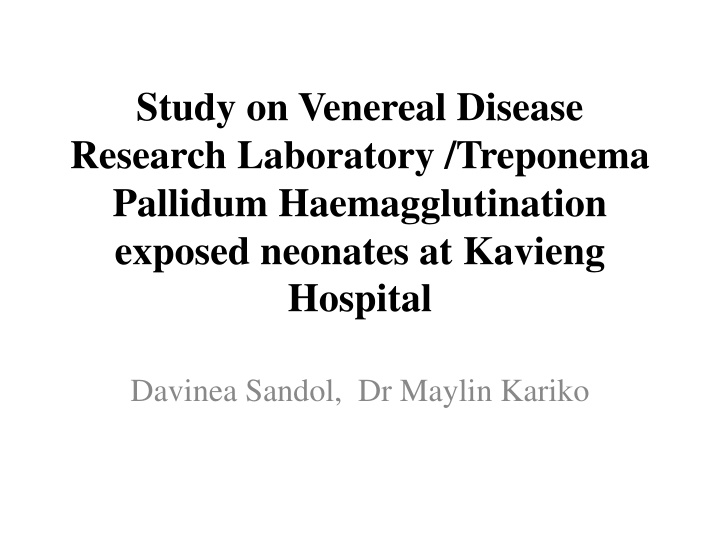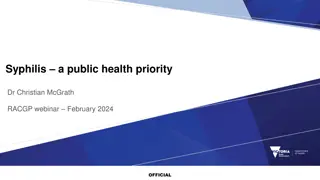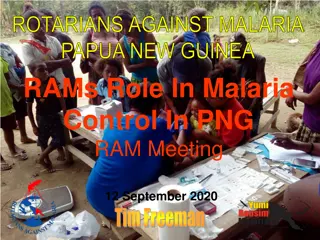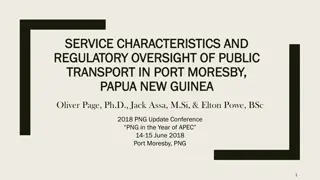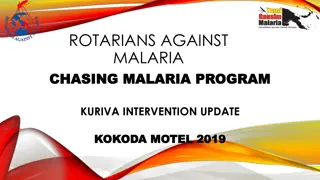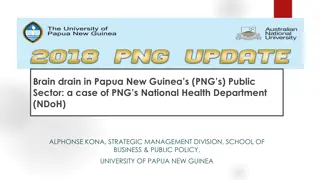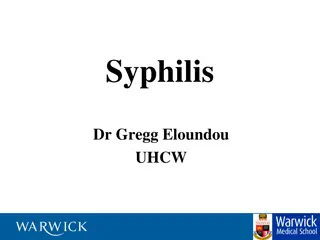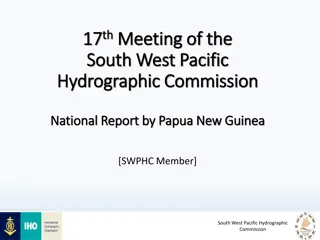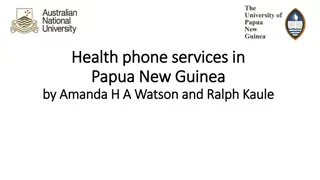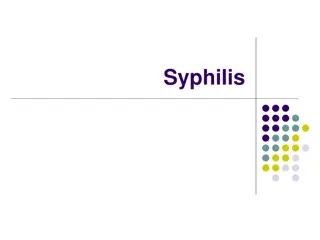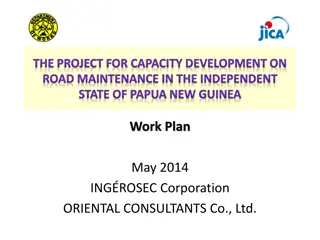Study on Congenital Syphilis in Papua New Guinea
Syphilis, a sexually transmitted infection caused by Treponema pallidum, remains a global health concern, especially in mother-to-child transmission. This study aims to determine the outcomes of neonates born to mothers positive for syphilis, exploring the proportion of symptomatic versus asymptomatic cases. Past research in Papua New Guinea has highlighted congenital syphilis as a significant issue, impacting neonatal morbidity and mortality. The methodology involves a prospective descriptive study at Kavieng Provincial Hospital, with neonates monitored for positive serology and clinical features of congenital syphilis. Statistical analysis will be conducted using IBM SPSS Statistics 20 and Microsoft Excel 2010.
Download Presentation

Please find below an Image/Link to download the presentation.
The content on the website is provided AS IS for your information and personal use only. It may not be sold, licensed, or shared on other websites without obtaining consent from the author.If you encounter any issues during the download, it is possible that the publisher has removed the file from their server.
You are allowed to download the files provided on this website for personal or commercial use, subject to the condition that they are used lawfully. All files are the property of their respective owners.
The content on the website is provided AS IS for your information and personal use only. It may not be sold, licensed, or shared on other websites without obtaining consent from the author.
E N D
Presentation Transcript
Study on Venereal Disease Research Laboratory /Treponema Pallidum Haemagglutination exposed neonates at Kavieng Hospital Davinea Sandol, Dr Maylin Kariko
Introduction Syphilis is a preventable and curable sexually transmitted infection (STI) that is caused by spirochete treponema pallidum Mother to child transmission of syphilis remains an important global public health problem. Syphilis in pregnancy when not treated, results in 50 80% of cases with adverse birth outcomes In pregnancy, it is a leading cause of stillbirth globally and also results in prematurity, low birth weight, neonatal death and infections in newborns.
Diagnosing congenital syphilis remains a challenge for developing countries like Papua New Guinea. Over the last three years, NIPHA O&G unit reports showed an increase in the number of mothers tested positive for syphilis Due to this trend, study was done to document outcomes of babies born to VDRL/TPHA positive mothers
Aim To determine what proportion of neonates born to VDRL/TPHA positive mothers develop symptoms of congenital syphilis and what proportion of neonates are asymptomatic.
Literature review In a study conducted between January 1998 to December 1999 in Goroka Base Hospital by Dr Frank and Prof Duke and published in the PNG medical Journal in the year 2000. The study showed congenital syphilis was a major cause of morbidity and mortality among neonates in the Eastern Highlands Province at that time. The major risk factor for death in affected babies was low birth weight.
Methodology Prospective descriptive study Time duration: February to August 2023 The study was carried out at Kavieng Provincial Hospital Mothers were consented and a standardized questionnaire was filled in by Paediatric medical team when consulted by O&G team Neonates from 0 to 28 days were recruited for this study and were followed up to two months of age Neonates were diagnosed with congenital syphilis with positive serology and presence of two or more clinical features Ethical clearance was sought prior to doing the study Statistical Analysis: IBM SPSS Statistics 20. software and Microsoft Excel 2010 was used for analysis of the data
Results 100 VDRL/TPHA exposed neonates were recruited in this study from the maternity ward at Kavieng Provincial Hospital Participants that took part in this study were from Kavieng District 90% (90) and Namatanai District 10% (10) Baseline Characteristics n 98 (0 -7) 61 Age (days) 1 ( 8 -14) 1 (14-28) Male 39 Female 3 (< 1.5 ) Birth Weight (kg) 15 (< 2.5) 82 (> 2.5) 6 (<37 ) Gestational Age (weeks) 94 (>37)
MATERNAL CHARACTERISTICS Characteristics Maternal Age Outcome 11% (11) 15-20 years 62% (62) 21-30 years 26% (26) 31-40 years 1% (1) 40+ years Characteristics Antenatal Clinic Outcome 95%(95) Booked 5% (5) Unbooked Maternal Parity 40% (40) One 37% (37) Two- Three 23% (23) >Four Education Level 1% (1) No Formal Education 43% (43) Primary Education 47% (47) Secondary Education 5% (5) Tertiary Education 4% (4) No record Marital Status 86% (86) Married 14% (14) Boyfriend
MATERNAL CHARACTERISTICS Characteristics Outcome Maternal Benzathine Penicillin Doses 51 % (51) were treated 20 % (20) were partially treated 28 % (28) were not treated 1 % (1) had no record Paternal Treatment 13% (13) were treated 13% (13) were partially treated 73% (73) were not treated 1% (1) had no record 73% (73) had 1 Partner 21% (21) had 2 Partners 3% (3) had >2 Partners 3% (3) had no record Number of Partners
SIGNS OF CONGENITAL SYPHILIS 120 95% 100 Number of neonates 80 60 40 20 5% 0 Symptomatic Asymptomatic
NEONATAL SEROLOGY RESULTS 7 (7%) Positive 27 (27%) Negative 66 No Record (66%)
MATERNAL TREATMENT VS NEONATAL SEROLOGY RESULTS Positive Negative Untreated 22 (81%) 5 27 Treated 30 (64%) 17 47 Partially Treated 13 (72%) 5 18 92
NEONATES WITH CONGENITAL SYPHILIS Clinical Signs of Congenital syphilis Number of Neonates (5) Birth Weight < 1.5Kg Birth Weight < 2.5 Kg Anaemia Jaundice Skin Rashes Desquamation 2/5 2/5 2/5 4/5 1/5 1/5
RELATIONSHIP OF MATERNAL TREATMENT WITH SYMPTOMATIC NEONATES Mothers treatment Symptomatic Neonates Untreated 2 Partially Treated 2 Fully Treated (treated in 3rdtrimester) 1
FOLLOW UP AT TWO MONTHS 43% 57% Asymptomatic Lost to follow up
VDRL Exposed Neonates (100) Missing Serology Results (7) Negative Serology Result (27) Positive Serology Result (66) Benzathine Penicillin stat (95) Clinical Signs (5) Asymptomatic (61) Follow Up (34) Crystalline Penicillin 10 days Follow Up (61) Lost to Follow Up (17) Follow Up (5) Lost to Follow Up (25) Lost To Follow Up (1) Symptomatic (0) Symptomatic (0) Symptomatic (0) Asymptomatic (17) Asymptomatic (4) Asymptomatic (36)
Discussion 100 neonates were recruited at birth, 5% of the study population had clinical features of congenital syphilis 95 % did not manifest any signs of congenital syphilis at birth so were given stat dose of benzathine penicillin - 53 were followed up at two months and all were asymptomatic For the 5% that were treated for congenital syphilis, 4 of the 5 were followed up and were asymptomatic at two months All VDRL/TPHA exposed babies who were treated at birth whether symptomatic or asymptomatic survived
Comparison of the maternal treatment and neonatal serology results showed a higher percentage with positive neonatal serology results in those mothers who were untreated and partially treated The neonates may manifest the early signs of congenital syphilis in the first two years of life and the late signs in the first two decades of life. For this reason, a longer term follow up period would have a better outcome
Limitations Short follow- up time Lost to follow on some of the patients Unavailability of reagents and test kits in the Lab
Conclusion Only 5% of the neonates were symptomatic at birth All those that were followed up (57%) at two months were generally well The outcome of the exposed neonates and those with congenital syphilis would be better appreciated if followed up for 2 years for the early signs and first two decades of life for the late signs of syphilis
Maternal treatment during pregnancy reduces the risk and incidence of congenital syphilis A stat dose of Benzathine Penicillin is sufficient but a long term follow up would have a better result
Recommendations Education and awareness in the communities Improve testing and treatment in ANC Health workers to be more vigilant in testing and treating syphilis A similar study could be done for village deliveries or deliveries at the rural health facilities to possibly capture untreated VDRL/TPHA exposed babies and their outcome
References Nelson Textbook of Pediatrics. Behrman et al. 17 ed. 2004 PNG Standard Treatment for Common Illnesses in Children.10thEd. 2016 PNG Med J 2000. Congenital Syphilis at Goroka Base Hospital: incidence, clinical features and risk factors for mortality. WHO Hospital Care for children. 13thEd.
Acknowlegement Prof Duke Dr Kariko (Paediatrician NIPHA) Dr Zzeferrio (NIPHA O&G SMO) and O&G Team Paediatric Team NIPHA (Dr Gugu, HEO Sio, HEO Loman, RMO Soagai, Paediatric nurses) Dr Justin Kali (Paediatrician) NIPHA CMO, DCS and Laboratory staff My family
